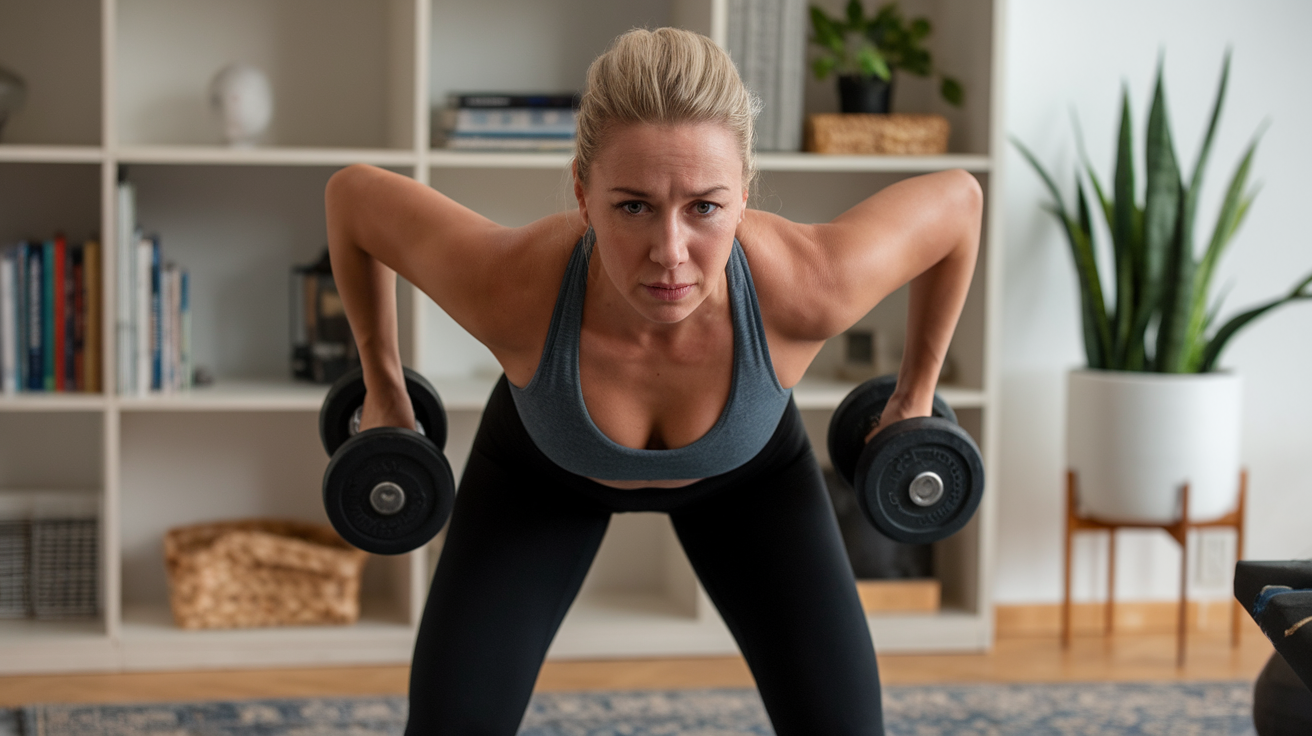Strength training at home offers a practical solution for busy women who can’t make it to the gym. Simple exercises using your body weight or basic equipment can build muscle, boost metabolism, and increase overall fitness right in your living room. The best part? You don’t need fancy machines or extensive space to get started.
A yoga mat, resistance bands, and a pair of light dumbbells are all you need for an effective home strength routine. These basic items create countless exercise possibilities while keeping your workout space minimal and organized. Plus, these tools are budget-friendly and easy to store, making them perfect for any home setup.
The following sections will guide you through six effective strength exercises that target different muscle groups. We’ll cover proper form, frequency recommendations, and ways to modify each movement based on your fitness level. Whether you’re new to strength training or looking to refresh your routine, these exercises will help you build strength and confidence in your own space. Let’s discover how to make the most of your home workouts.
What Makes These 6 Exercises Perfect for Beginners?

Starting a strength training routine doesn’t require complex equipment or advanced knowledge. These six exercises stand out for beginners because they focus on natural movements your body already knows how to do. Your own body weight serves as the primary resistance, making these exercises both effective and accessible.
Understanding Body Weight Resistance
Your body is a natural weight machine. Standing up from a chair, climbing stairs, or picking up groceries – these daily activities already use body weight resistance. By practicing controlled versions of these movements, you’ll build strength in a way that directly improves your everyday life.
Body weight exercises help you master control and stability before adding external weights. Think of it like learning to walk before running – you need to understand how your body moves through space first.
Benefits of Minimal Equipment Exercises
A resistance band and a pair of light dumbbells can transform your home workout space. These simple tools add variety to basic movements without overwhelming you with complicated setups.
Here’s what makes minimal equipment exercises so effective:
- Easy to store and transport
- Cost-effective compared to gym memberships
- Versatile for multiple exercise variations
- Safe for solo workouts
- Simple to maintain and clean
Proper Form Fundamentals
Good form prevents injuries and maximizes results. Start each exercise slowly, focusing on your breathing and muscle engagement. If something feels uncomfortable or causes pain, stop and adjust your position.
Pay special attention to your core engagement during every exercise. Think about pulling your belly button toward your spine while keeping your back straight. This creates a strong foundation for all movements.
Time-efficient Workouts
These exercises work multiple muscle groups simultaneously, saving you precious time. A complete workout takes just 20-30 minutes, perfect for busy schedules. You can even split the exercises throughout your day – try a few in the morning and finish the rest after work.
The key is consistency rather than lengthy sessions. Short, focused workouts done regularly yield better results than sporadic long sessions.
Modifications for Different Fitness Levels
Every exercise can be adjusted to match your current strength level. If regular push-ups feel too challenging, start with wall push-ups or knee push-ups. As you grow stronger, progress to more demanding variations.
Listen to your body and progress at your own pace. Some days you might need to scale back, while others you’ll feel ready for more challenge. This flexibility makes these exercises perfect for long-term fitness growth.
Building strength is a gradual process, and these exercises provide a solid foundation. Start with the basic versions, master the movements, and watch your strength improve week by week.
Which Muscle Groups Do These Exercises Target?

Understanding which muscles you’re working helps you get the most from each exercise. A well-rounded strength routine targets multiple muscle groups, creating balanced strength throughout your body.
Upper Body Focus Areas
Your arms, shoulders, and chest form the foundation of upper body strength. Push-ups and dumbbell exercises activate these muscle groups simultaneously. The triceps at the back of your arms get special attention during these movements, helping reduce arm wobble.
Working your upper body improves posture and makes daily tasks easier. Here are the main muscles targeted in these exercises:
- Deltoids (shoulders)
- Pectorals (chest)
- Biceps and triceps (arms)
- Upper back muscles
- Forearms
Core Strengthening Benefits
A strong core does more than create flat abs – it supports your spine and improves balance. Planks and similar exercises strengthen deep abdominal muscles that regular crunches don’t reach.
The core includes muscles in your sides and lower back too. These stabilizer muscles prevent back pain and maintain good posture throughout the day. Regular core work improves stability in all other exercises.
Lower Body Engagement
Your legs contain the largest muscles in your body, making them crucial for metabolism and overall strength. Squats and lunges target multiple leg muscles at once, creating efficient movement patterns.
Strong legs support your joints and make climbing stairs easier. The gluteal muscles, particularly important for women, get activated during these exercises, improving hip stability and reducing knee pain.
Full-body Coordination
Moving multiple muscle groups together creates functional strength. These exercises teach your body to work as one unit, similar to real-life movements like carrying groceries or picking up children.
Good coordination reduces injury risk and improves athletic ability. Each exercise builds upon the others, creating smooth, controlled movements that translate to better physical performance.
Balanced Muscle Development
Working opposing muscle groups prevents imbalances that could lead to injury. For example, strengthening both your chest and back muscles maintains proper shoulder alignment.
Your muscles need equal attention on both sides of your body. Right-handed people often have stronger muscles on their dominant side, but these exercises help correct such imbalances naturally.
The combination of these muscle groups creates a complete workout system. Each exercise flows into the next, maintaining continuous muscle engagement throughout your session.
How Often Should You Do These Strength Exercises?

Finding the right workout frequency creates a sustainable fitness routine. Your body needs both challenge and rest to build strength effectively, so let’s explore the optimal schedule for these exercises.
Ideal Workout Frequency
Starting with two to three sessions per week gives your muscles time to recover between workouts. Space these sessions out – try Monday, Wednesday, and Friday, or Tuesday and Thursday. This schedule provides enough stimulus for strength gains while preventing burnout.
Your weekly workout schedule should match your current fitness level. These key factors determine your optimal training frequency:
- Current activity level
- Sleep quality
- Stress levels
- Recovery ability
- Available time
Rest and Recovery Guidelines
Muscles grow stronger during rest, not during exercise. Take at least one full day between strength sessions to allow proper recovery. Light activities like walking or stretching on rest days help maintain mobility without overtaxing your muscles.
Sleep plays a crucial role in recovery. Aim for 7-8 hours each night to support muscle repair and growth. Poor sleep can slow your progress and increase injury risk.
Progressive Overload Techniques
Start with two sets of 10 repetitions for each exercise. Once this feels manageable, add another set or increase the repetitions. This gradual progression builds strength safely and steadily.
Your muscles adapt to exercise over time, so small increases in difficulty maintain progress. Add resistance bands or light weights only after mastering body weight movements.
Workout Duration Recommendations
A complete session should last 20-30 minutes, including warm-up and cool-down. Quality matters more than quantity – focus on proper form rather than rushing through exercises.
Short, focused workouts fit easily into busy schedules. You might split the routine into two 15-minute sessions if that works better for your day.
Signs of Proper Intensity
Your breathing should quicken but allow conversation during exercises. Muscle fatigue should feel challenging but not painful. The last few repetitions of each set should require extra effort.
Pay attention to how you feel the day after working out. Mild muscle soreness is normal, but sharp pain signals too much intensity. Adjust your workout based on these physical cues.
Your body gives clear signals about exercise intensity. If you can complete all repetitions with perfect form but feel tired afterward, you’ve hit the sweet spot for building strength.
What’s the Perfect Form for Each Exercise?

Proper form maximizes results and prevents injury during strength training. Each movement requires specific attention to detail, from your head position to your toe alignment.
Starting Positions and Alignment
Your starting stance sets the foundation for each exercise. Stand with feet hip-width apart, shoulders pulled back, and head aligned with your spine. This neutral position creates stability and proper muscle activation.
These fundamental alignment points apply to all exercises:
- Feet firmly planted on the ground
- Knees tracking over toes
- Hips squared and level
- Core engaged
- Shoulders away from ears
Common Form Mistakes to Avoid
Many women arch their backs during planks or round their shoulders in push-ups. Watch yourself in a mirror or record your movements to spot these issues. Rushing through movements often leads to poor form.
Keep your neck neutral during all exercises. Looking up or down changes your spine alignment and can strain neck muscles. Similarly, avoid letting your knees cave inward during squats or lunges.
Breathing Techniques
Coordinating breath with movement powers your exercises. Exhale during exertion (pushing, lifting, or rising) and inhale during the easier phase (lowering or returning to start). This pattern helps maintain core stability.
Deep belly breathing supports your movements better than shallow chest breathing. Place one hand on your stomach and feel it expand with each inhale. Your breathing should be steady and controlled throughout the workout.
Range of Motion Guidelines
Moving through full range of motion builds better strength and flexibility. In a squat, lower until your thighs are parallel to the floor, keeping your chest lifted. For push-ups, lower until your elbows form 90-degree angles.
However, work within your current flexibility limits. Forcing movements beyond your comfortable range can cause injury. As you practice, your range will naturally increase.
Proper Engagement Cues
Think about squeezing a penny between your shoulder blades during rows. Imagine pressing the floor away during push-ups. These mental cues help activate the right muscles at the right time.
Your core acts as a natural weight belt. Draw your belly button toward your spine while maintaining normal breathing. This engagement protects your lower back during all movements.
Small adjustments in form create big differences in results. Focus on one improvement at a time, mastering each element before adding complexity to your movements.
Ready to Level Up Your Home Strength Training?
Once you’ve mastered the basic movements, your body will start asking for new challenges. Progress happens when you gradually increase difficulty while maintaining proper form.
Adding Resistance Variations
Simple equipment can transform basic exercises into challenging new versions. A resistance band around your thighs during squats activates different muscle fibers. Light dumbbells add intensity to lunges and overhead presses.
Consider these proven ways to add resistance to your routine:
- Resistance bands of varying strengths
- Adjustable dumbbells
- Filled water bottles as weights
- Backpack with books
- Household items like canned goods
Increasing Repetitions Effectively
Your muscles adapt to repetition counts quickly. Start by adding two reps to each set every week. If you currently do 10 push-ups, try 12 next week. This gradual increase prevents burnout while building endurance.
The quality of movement matters more than quantity. Perfect form with fewer reps builds more strength than sloppy form with many reps. Take brief pauses between sets to maintain technique.
Creating Exercise Combinations
Pair complementary movements together to save time and increase intensity. Try a squat followed immediately by a push-up. This combination works different muscle groups while keeping your heart rate elevated.
Mix upper and lower body exercises to maintain steady energy throughout your workout. A pull-up followed by a lunge creates balanced muscle engagement and improves coordination.
Tracking Progress Methods
Numbers tell the story of your improvement. Write down your reps, sets, and resistance levels after each workout. Small wins add up to significant changes over time.
Take monthly measurements of your arms, legs, waist, and hips. Progress photos from the same angle and lighting show changes that numbers might miss. Track your energy levels and mood to see how strength training affects your daily life.
Advanced Modification Options
Speed changes create new challenges. Try slowing down the lowering phase of each movement to 4 seconds. This technique, called eccentric training, builds strength and control.
Add pulses at the bottom of movements. During a squat, pulse three times before standing up. These small movements target specific muscle fibers and increase endurance.
Your body responds best to gradual changes. Pick one modification at a time and practice it for several weeks before adding another challenge to your routine.
Your Path to Stronger Days Ahead
Building strength at home opens a world of possibilities for women seeking fitness on their terms. These six exercises create a foundation for better posture, increased energy, and improved daily function – from carrying groceries to playing with kids. The beauty of this routine lies in its simplicity: start where you are, progress at your pace, and watch your strength grow week by week.
Your body will tell you when it’s ready for new challenges. Listen to those signals, adjust your movements accordingly, and celebrate each small victory along the way. The strength you build through these exercises extends far beyond physical gains – it creates confidence, independence, and a deeper connection with your body’s capabilities. Every rep brings you closer to your strongest self, right in the comfort of your home.
Frequently Asked Questions
Q: How many times per week should I do these strength exercises?
A: Start with 2-3 sessions per week, spacing them out with rest days in between, such as Monday-Wednesday-Friday or Tuesday-Thursday.
Q: Do I need special equipment to start strength training at home?
A: No, you can start with just your body weight. Basic equipment like resistance bands and light dumbbells can be added later to increase difficulty.
Q: How long should each workout session last?
A: A complete session should last 20-30 minutes, including warm-up and cool-down periods.
Q: How do I know if I’m using the correct form?
A: Proper form includes keeping your spine neutral, shoulders back, core engaged, and breathing steadily. Using a mirror or recording yourself can help check your form.
Q: When should I increase the difficulty of my exercises?
A: Increase difficulty when you can complete all sets and reps with perfect form and feel you need more challenge. Add 2 reps per set each week.
Q: What’s the best way to track progress?
A: Record your reps, sets, and resistance levels after each workout, take monthly body measurements, and progress photos from consistent angles.
Q: How should I breathe during these exercises?
A: Exhale during exertion (pushing, lifting, or rising) and inhale during the easier phase (lowering or returning to start position).
Q: What are signs that I’m working at the right intensity?
A: You should be able to talk during exercises but feel challenged. The last few reps should require extra effort, and mild muscle soreness the next day is normal.

